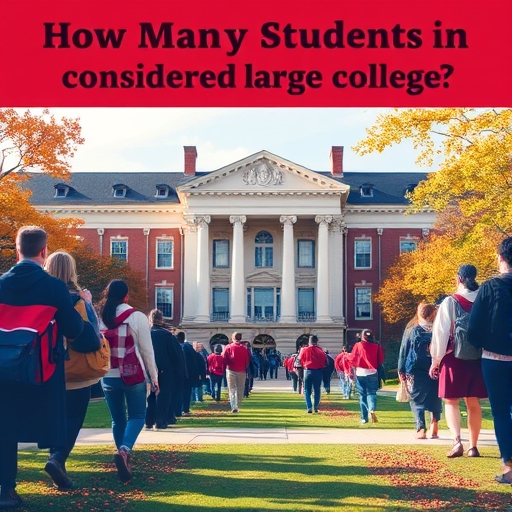How Many Students is Considered a Large College?
When considering higher education, one of the factors that prospective students often think about is the size of the college or university. The size of an institution can significantly influence the student experience, campus culture, and available resources. But what exactly constitutes a “large” college? In this article, we will explore the definitions, implications, and experiences associated with large colleges, along with some comparisons to smaller institutions.
Understanding College Sizes
Colleges and universities can typically be categorized into three main size groups:
- Small Colleges: Usually have fewer than 1,500 students.
- Medium Colleges: Generally enroll between 1,500 to 5,000 students.
- Large Colleges: Typically have more than 5,000 students.
- Independent Learners: Those who thrive in large settings may appreciate the independence and variety offered by a large college.
- Personalized Attention: If you prefer close interactions with professors and smaller class sizes, a small or medium college may be better suited for you.
- Networking Opportunities: Large colleges often have extensive alumni networks and connections to industries, which can be beneficial for job placement.
- Specialized Programs: Consider whether the college offers the specific programs or majors you are interested in.
- Social Life: Think about whether you want a bustling campus with numerous activities or a quieter, more intimate setting.
- Diversity: A larger college may provide a more diverse environment, which can enhance your educational experience.
- Tuition and Fees: Often, larger public colleges may offer lower tuition rates for in-state students compared to smaller private institutions.
- Scholarships and Financial Aid: Research the availability of scholarships and financial aid, as larger institutions may have more resources to offer.
Defining Large Colleges
While the above definitions provide a basic framework, the term “large college” can vary depending on the context. For example, a college with 5,000 students may be considered large in some regions but medium-sized in urban areas or in comparison to major research universities that can enroll tens of thousands of students.
Characteristics of Large Colleges
1. Student Population: As mentioned, large colleges usually have enrollment figures exceeding 5,000 students. Some of the largest universities in the U.S. have student populations that surpass 50,000.
2. Diverse Programs: Large colleges tend to offer a wide variety of undergraduate and graduate programs, often including specialized degrees and research opportunities.
3. Campus Resources: These institutions typically have more extensive facilities, including libraries, laboratories, and recreational centers.
4. Extracurricular Opportunities: Large colleges often feature a broad range of clubs, organizations, and activities, catering to various interests.
5. Diversity: Larger student populations often lead to a more diverse student body, including various ethnicities, backgrounds, and international students.
Comparison of College Sizes
| College Size | Student Enrollment Range | Characteristics |
|---|---|---|
| Small Colleges | Fewer than 1,500 | Personalized attention, small class sizes, close-knit community |
| Medium Colleges | 1,500 – 5,000 | Balanced resources, moderate class sizes, good variety of programs |
| Large Colleges | More than 5,000 | Extensive resources, diverse programs, large student organizations |
Advantages of Attending a Large College
Choosing a large college can offer several benefits that may appeal to various students’ preferences and academic goals.
1. Variety of Academic Programs
Large colleges typically provide a diverse array of academic programs, allowing students to explore different fields of study. This can be particularly advantageous for undecided students who want to explore various disciplines before committing to a major.
2. Research Opportunities
Many large colleges are research institutions, which means they often have significant funding for research projects. Students may have the opportunity to work alongside faculty on groundbreaking research, gaining valuable experience in their field.
3. Networking and Career Opportunities
With a larger alumni network and connections to various industries, students at large colleges may find it easier to secure internships and job placements after graduation. Many employers actively recruit from larger universities due to their reputation and resources.
4. Campus Life and Activities
Large colleges often boast vibrant campus life with numerous clubs, organizations, and events. Students can participate in various extracurricular activities, from sports to cultural organizations, enhancing their college experience.
5. Diverse Student Body
Attending a large college can expose students to a wide range of perspectives and cultures, fostering a more inclusive environment. This diversity can enrich the educational experience and prepare students for a global workforce.
Challenges of Attending a Large College
While there are numerous advantages to attending a large college, there are also challenges that students may encounter.
1. Less Personalized Attention
In large lecture halls, students may find it difficult to receive personalized attention from professors. This can impact the quality of education and the level of interaction between students and faculty.
2. Competition
With more students vying for the same resources, such as academic advising, internships, and research positions, competition can be fierce at large institutions.
3. Navigating Campus
Large campuses can be challenging to navigate, especially for first-year students. Finding classrooms, administrative offices, and other facilities can be overwhelming.
4. Feeling Disconnected
Some students may feel lost in a sea of thousands of peers. This sense of anonymity can lead to feelings of isolation, particularly for those who thrive in smaller, more intimate settings.
5. Limited Access to Resources
Although large colleges have more resources overall, specific programs or facilities may be overwhelmed by the number of students, leading to longer wait times or limited access.
Factors to Consider When Choosing a College Size
Choosing the right college size involves considering several factors that align with your personal preferences and academic goals. Here are some critical points to ponder:
1. Learning Style
2. Career Goals
3. Campus Environment
4. Financial Considerations
Frequently Asked Questions (FAQ)
What is the largest college in the United States?
The largest college in the U.S. by enrollment is the University of Central Florida, with over 70,000 students. Other large institutions include Texas A&M University and the University of Florida.
Are large colleges better than small colleges?
The answer depends on individual preferences and needs. Large colleges offer diverse programs, resources, and networking opportunities, while small colleges provide personalized attention and a close-knit community.
How do I choose between a large and small college?
Consider your learning style, career goals, campus environment preferences, and financial situation. Visiting campuses and talking to current students can also help inform your decision.
Can I transfer between college sizes?
Yes, many students transfer between colleges of different sizes. However, you should research the transfer policies and how credits will transfer to ensure a smooth transition.
Do large colleges have more extracurricular activities?
Generally, large colleges offer a wider variety of extracurricular activities due to their larger student population. However, smaller colleges may have more intimate and specialized organizations.
Conclusion
Determining how many students is considered a large college involves understanding the context and characteristics of different institutions. While large colleges typically have more than 5,000 students, the implications of attending such a school can vary widely.
From diverse academic programs and extensive resources to challenges like less personalized attention, prospective students must evaluate their preferences and goals carefully. By weighing the advantages and disadvantages of large colleges, students can make informed decisions that align with their educational aspirations and personal needs.
Whether you choose to attend a large college or a smaller institution, remember that the college experience is what you make of it—engagement, exploration, and connection can happen in any setting.





